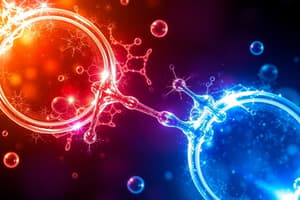Podcast
Questions and Answers
What type of bonding occurs primarily in metals?
What type of bonding occurs primarily in metals?
- Polar covalent bonding
- Ionic bonding
- Metallic bonding (correct)
- Hydrogen bonding
Which type of bonding involves the sharing of electrons between two atoms?
Which type of bonding involves the sharing of electrons between two atoms?
- Covalent bonding (correct)
- Polar covalent bonding
- Ionic bonding
- Metallic bonding
What type of bond results in the formation of slightly positive and negative charges on different parts of the molecule?
What type of bond results in the formation of slightly positive and negative charges on different parts of the molecule?
- Ionic bonding
- Hydrogen bonding
- Metallic bonding
- Covalent bonding (correct)
Which type of bond is characterized by high melting and boiling points, excellent conductivity, and metallic luster?
Which type of bond is characterized by high melting and boiling points, excellent conductivity, and metallic luster?
In which type of bond do metal atoms lose electrons to form a sea of delocalized electrons?
In which type of bond do metal atoms lose electrons to form a sea of delocalized electrons?
Which type of bond involves the interaction responsible for the aggregation of atoms into molecules, ions, and crystals?
Which type of bond involves the interaction responsible for the aggregation of atoms into molecules, ions, and crystals?
What type of bonding occurs when one atom loses an electron to another atom?
What type of bonding occurs when one atom loses an electron to another atom?
In which type of bond do atoms share electrons unequally?
In which type of bond do atoms share electrons unequally?
What type of bond involves a weak attraction between a positively charged hydrogen atom and a highly electronegative atom?
What type of bond involves a weak attraction between a positively charged hydrogen atom and a highly electronegative atom?
Which type of bond has oppositely charged ions attracting each other due to electrostatic forces?
Which type of bond has oppositely charged ions attracting each other due to electrostatic forces?
Which bond exhibits better stability due to an even distribution of charge between atoms?
Which bond exhibits better stability due to an even distribution of charge between atoms?
What type of bond is responsible for the unique physical properties of water, such as expansion upon freezing?
What type of bond is responsible for the unique physical properties of water, such as expansion upon freezing?
Flashcards are hidden until you start studying
Study Notes
Chemical Bonding: Metallic, Covalent, Ionic, Polar Covalent, and Hydrogen Bonding
Overview
Chemical bonding refers to the interactions responsible for the aggregation of atoms into molecules, ions, crystals, and other stable species, allowing the formation of various materials used in daily life. Although chemists rely on quantum mechanics to obtain a detailed understanding of bond formation, simple intuitive models are often employed to explain the existence of compounds and their properties. The four main types of chemical bonds are metallic, covalent, ionic, and polar covalent, with hydrogen bonding being another significant interaction.
Metallic Bonding
Metallic bonding occurs primarily in metals, where the metal atoms lose electrons to form a sea of delocalized electrons, creating a net attractive force among the remaining positively charged atomic cores. This force holds the atoms tightly together, resulting in high melting and boiling points, excellent conductivity, and characteristic metallic luster.
Covalent Bonding
Covalent bonding involves the sharing of electrons between two atoms, leading to a more stable molecular arrangement. These bonds can be either nonpolar (equally shared electrons) or polar (unequal sharing of electrons). Examples include molecular oxygen and methane. Polar bonds result in the formation of slightly positive and negative charges on different parts of the molecule.
Ionic Bonding
In ionic bonding, one atom loses an electron to another atom, which then gains the electron. This process creates oppositely charged ions that attract each other due to electrostatic forces, leading to the formation of stable compounds like sodium chloride. Ionic compounds are highly crystallized and have high melting and boiling points, making them excellent conductors when dissolved in water or melted.
Polar Covalent Bonding
Polar covalent bonds occur when atoms share electrons unequally, resulting in slight positive and negative charges on different parts of the molecule. Examples include hydrogen fluoride and ammonium acetate. These bonds are more stable than nonpolar covalent bonds because they distribute charge more evenly, providing better stability and balance between the two atoms.
Hydrogen Bonding
Hydrogen bonding is a weak, long-range attraction between a positively charged hydrogen atom connected to a highly electronegative atom (e.g., O, N, or F) and another electronegative atom in another molecule. The most famous example of hydrogen bonding is found in water, where hydrogen bonding gives rise to unique physical properties such as expansion upon freezing. Hydrogen bonds can also play a role in determining the solubility of materials in water and the efficiency of enzymatic catalysis.
Studying That Suits You
Use AI to generate personalized quizzes and flashcards to suit your learning preferences.




